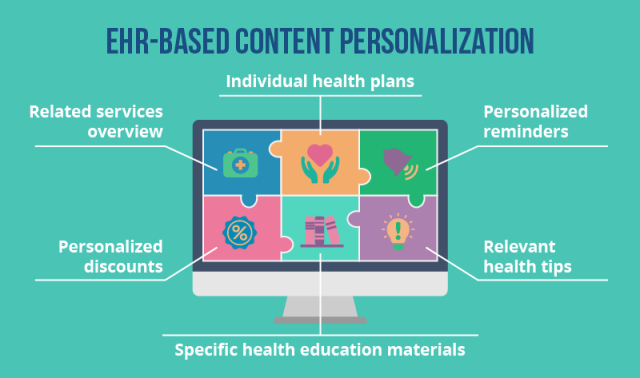By: Uladzimir Sinkevich
Content personalization is a powerful tool for building trust on a medical website, making patients feel special, privileged and taken care of. Based on visitor preferences, search intent and behavior during previous visits, it offers a tailored user experience, such as personalized messages, promotions and services.
Generally, medical resources tend to provide users with a certain level of personalization through a private patient portal with access to their EHR/ EMR, appointment scheduling, diagnosis information, examination results and other features.
However, the public realm of the website (including service descriptions, articles and more) can benefit from using EHR-based information, too. The resource can actively guide patients and suggest relevant information backed by selected health data entries.
Both patients and caregivers can benefit from an EHR-based content personalization.

Particularly, patients receive:
- Personalized promotions
- Overview of services related to their conditions
- Targeted messages (health tips, reminders, articles)
In the course of a long-lasting relationship between a patient and a provider, an EHR contains diagnosis with dozens of lab results, images as well as examination and treatment records. Summarizing these entries, the medical website can help build credibility by offering patients accurate information.
On the flip side, caregivers benefit from two advantages:
- Gaining more loyal patients
- Improving population health
One of the most important KPIs for health organizations is the level of a population’s health. Achieving a higher level of a population’s well-being is easier when caregivers place a major focus on preventive medicine. While patients have a more personalized user experience on a medical website, they tend to care about their own health and thus prevent diseases.
Now, there is a catch. HIPAA restricts the use of the protected health information for marketing purposes. The privacy rules, however, allow clinical websites to personalize functionality to tell patients about the “services essential for quality health care”, for example:
- Previews of pages with health plan guides related to patients’ current health plans or conditions
- Shortcuts to new service descriptions according to patients’ health records
- Personal reminders and/or discounts relevant to recent patients’ checks and procedures
However, most of the EHR data is useless for website personalization.
Thus, a medical website needs an algorithm that will collect a short health record overview with the elements valuable for personalization only. At ScienceSoft, we call it a “Health Profile Builder” algorithm. Its job is to sort out the massive amounts of personal information in EHR and extract the key data inputs, such as lab results, X-rays, discharge summaries and other. Then, the “Builder” can answer the following patient needs, such as:
- Information needs
- Care needs
- Examination needs
- Treatment needs
So, let’s see how it works. A patient with a chronic condition, say, diabetes, has a long history of blood/urine glucose tests, pancreatic/liver ultrasounds, MRI results and more.

The “Builder” extracts the diagnosis information via the ICD-10 codes. Based on this and other data from the EHR, the algorithm detects possible complications and provides particular personalization options. As risk factors for diabetes include neuropathy, high blood pressure, retinopathy, skin complications and more, the website offers:
- a discount for the next consultation
- a free blood pressure check
- an article about neuropathy and foot hygiene
This information might be a just-in-time act of care for a person with diabetes, as patients with chronic conditions tend to underestimate the actual severity of their disease.
Open Dialogue with Patients
Personalized website content can help a healthcare organization create the effect of visiting a doctor’s office, thus building a trustful relationship with patients. As using EHR-based information is just a small part of the content personalization topic, you can read more details on how to customize the user experience in one of our latest blog posts. We encourage you to follow the link and let us know about your thoughts in the comments.













